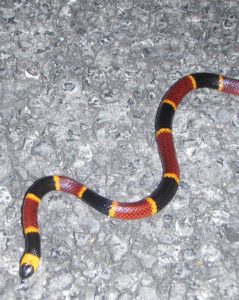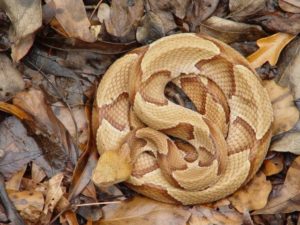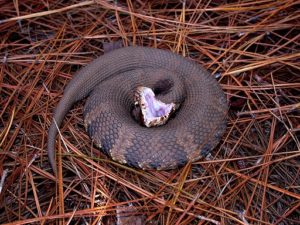First of all, there’s really nothing to be afraid of. Venomous snakes in the Houston area are not as dangerous as people think they are. Keep calm. Now, I’m not saying you should go pick up a venomous snake, and kiss it on the lips, but they’re really not that aggressive. Venomous snakes get a bad rap. Very few people actually die in the U.S. from snakebite. The best ways to deal with venomous snakes, is to give them their distance (when you can) and to educate yourself about the common species of local venomous snake.
 The most potently venomous snake in our area is the Texas Coral Snake, which is in the cobra family. Sounds scary, right? You definitely shouldn’t touch one, but they are shy snakes, that prefer to hide out under rocks and logs, in rodent burrows, and will flee, rather than hiss or strike, when surprised. Texas coral snakes have a distinctive red-yellow-black color pattern, which could also be described as alternating red and black sections separated by “gold rings.” They are thin snakes, that are usually only 2 – 2.5 feet long. These beautiful little reptiles eat mostly other snakes and small lizards, and they spend most of their time underground.
The most potently venomous snake in our area is the Texas Coral Snake, which is in the cobra family. Sounds scary, right? You definitely shouldn’t touch one, but they are shy snakes, that prefer to hide out under rocks and logs, in rodent burrows, and will flee, rather than hiss or strike, when surprised. Texas coral snakes have a distinctive red-yellow-black color pattern, which could also be described as alternating red and black sections separated by “gold rings.” They are thin snakes, that are usually only 2 – 2.5 feet long. These beautiful little reptiles eat mostly other snakes and small lizards, and they spend most of their time underground.
Southern Copperheads are most likely to be found in areas with trees. They can be very  well camouflaged on forest floors covered in leaf litter. They are also rather shy snakes, have relatively milder venom than other area venomous snakes, and are not usually likely to bite. As with all venomous snakes though, give them some distance. Compared to other venomous snakes, they have an unusually wide variety of prey items, including: rodents, frogs, fish, lizards, birds, and large insects. Unlike coral snakes and most non-venomous snakes, Copperheads have elliptical “cat-like” pupils and heat sensing pits located between the eye and the nostril on each side of the head.
well camouflaged on forest floors covered in leaf litter. They are also rather shy snakes, have relatively milder venom than other area venomous snakes, and are not usually likely to bite. As with all venomous snakes though, give them some distance. Compared to other venomous snakes, they have an unusually wide variety of prey items, including: rodents, frogs, fish, lizards, birds, and large insects. Unlike coral snakes and most non-venomous snakes, Copperheads have elliptical “cat-like” pupils and heat sensing pits located between the eye and the nostril on each side of the head.
 The aquatic Cottonmouth, which is also a pit-viper, also has the heat pit and slit-like pupils. The Cottonmouth is strongly venomous, and has a bad reputation for being aggressive, but recent scientific studies into their behavior has shown that they are actually not that likely to bite when encountered. Their fearsome hissing gaping mouth display, and occasional habit of fleeing in the direction of someone who has cornered them, have led many to believe that they are more aggressive than they actually are. Cottonmouths are almost always found in or near water. They sometimes climb onto low branches to sun themselves and keep an eye out for prey in the water below. They prefer to feed on frogs and fish, but they are one of the few snakes that will scavenge various dead animals, as well.
The aquatic Cottonmouth, which is also a pit-viper, also has the heat pit and slit-like pupils. The Cottonmouth is strongly venomous, and has a bad reputation for being aggressive, but recent scientific studies into their behavior has shown that they are actually not that likely to bite when encountered. Their fearsome hissing gaping mouth display, and occasional habit of fleeing in the direction of someone who has cornered them, have led many to believe that they are more aggressive than they actually are. Cottonmouths are almost always found in or near water. They sometimes climb onto low branches to sun themselves and keep an eye out for prey in the water below. They prefer to feed on frogs and fish, but they are one of the few snakes that will scavenge various dead animals, as well.
Venomous snakes are rightfully a source of fear and fascination. They’re helpful predators that keep rodent populations in check, and are therefore an integral part of local eco-systems. Also, they’re not usually that dangerous if given a respectful distance. However, if you should be bitten by a venomous snake, don’t attempt any home treatments, just get to a hospital as quickly and calmly as possible. Do not kill the snake. If you’d like to learn more about them, visit the nature center and talk to one of our naturalists.



